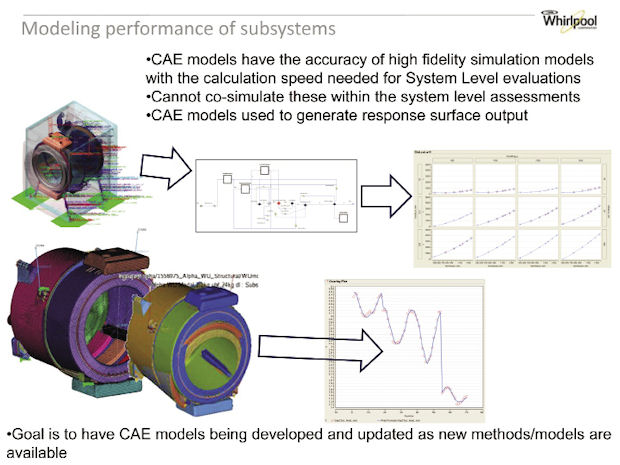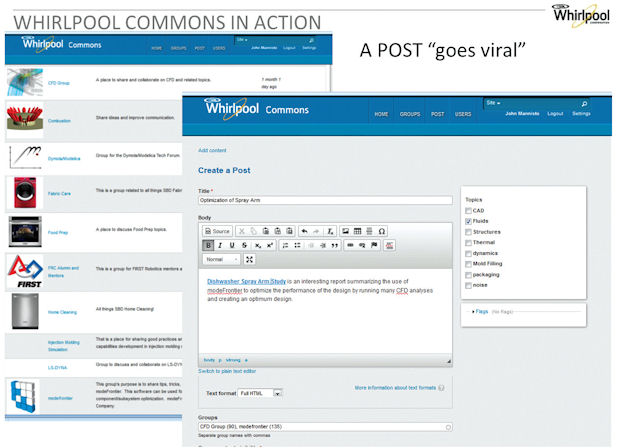
Whirlpool relies on ESTECO’s modeFRONTIER software as a dashboard to coordinate different simulation tasks. It’s part of the company’s system-level design philosophy, as reflected in this presentation slide.
Latest News
June 1, 2014
- Whirlpool relies on ESTECO’s modeFRONTIER software as a dashboard to coordinate different simulation tasks. It’s part of the company’s system-level design philosophy, as reflected in this presentation slide.
She meant, instead of sitting by the phone for weekly updates from her, Mannisto should just “follow” her on Twitter—that is, to subscribe to her Twitter feed. That incident, along with a Skype video chat with his grandkids and a Facebook page shared by the company-sponsored FIRST Robotics team, alerted him of something many business executives might find difficult to accept: Social media has outpaced corporate collaboration.
Today, Mannisto’s team uses Whirlpool Commons, incorporating many of the features of Twitter and Facebook. Team members subscribe to—or “follow,” in the jargon of Mannisto’s daughter—and receive project updates. They post questions and ideas to the Commons, as the platform has come to be known internally, and watch them go viral. Sometimes they discover colleagues several continents away that have the expertise they need to finish a job.
Often, when Mannisto talks about the Commons at business seminars and data management conferences, people want to know who the vendor is. He takes great pleasure in informing them that the Commons was the brainchild of Alex Otten, a 17-year-old intern he hired from a FIRST Robotics team.
Built in Open-source Code
Traditionally, a corporation like Whirlpool—with $18 billion in revenue and 68,000 employees, selling its products in more than 130 countries—turns to one of a handful of enterprise software vendors when it needs something. But Mannisto realized a new type of tool was needed to facilitate the new behaviors he’d observed among consumers and software users. He looked beyond the commercial software choices, and decided instead to outline his team’s needs and let his intern custom-develop something.
The first incarnation of the Commons was more than what Mannisto bargained for, because Otten had created a platform that showed off everything he knew about web design. “It was something that would have given my engineers seizure,” Mannisto recalls with a chuckle. He asked for a revised version that would be easily adopted by “the 50-something guys on my team who learned to use the Internet six or seven years ago.” That eventually put the Commons on the right track.
Whirlpool Commons was designed mostly in open source software: Drupal for content management, SilverStripe for web development, and Apache Solr for enterprise search. It began as a local implementation for Mannisto’s engineering group, but quickly spread to other divisions because of its ease of use.
Structured and Unstructured Data
At first glance, Whirlpool engineers seem to straddle two separate worlds: the unstructured knowledge shared in the Commons; and the structured data managed in PTC Windchill, a product lifecycle management (PLM) system, and ESTECO’s modeFRONTIER, an optimization integration platform. But the two worlds are inseparably linked. What happens in the Commons produce ripple effects in the revision controls in Windchill and the system modeling tasks in modeFRONTIER.
“System modeling requires a high degree of collaboration. It is, by nature, a group project, with lots of team input,” observes Mannisto, noting that in the Commons, he has witnessed unlikely collaborations spring up among employees in Rio Claro, Brazil; Poprad, Slovakia; and St. Joseph, MI. “modeFRONTIER gets hungry for input, so having a tool like Whirlpool Commons gives us the ability to feed it. The source of input comes from many unexpected places. One director of testing posted a question [to the Commons] about testing air flow to his team around the globe. He hadn’t anticipated that one of the responses would be from a simulation team member who sits 15 ft. from his desk.”
Using modeFRONTIER as the multidisciplinary project dashboard, Whirlpool can study and analyze the interrelated electromechanical simulation inputs and outputs—for example, how changing the foam thickness of the refrigerator cabinet and the type of compressor used might affect the overall experience of the consumer. But such initiatives and discussions can only occur within an environment that fosters cross-disciplinary dialogues and knowledge sharing. Though inputs and outputs in Whirlpool Commons and modeFRONTIER are not formally linked, the Commons promotes the culture needed for system modeling in modeFRONTIER.
Benefit to the Consumer
For Whirlpool, system modeling—the coordinated simulation and analysis of the subcomponents in a product—is not an abstract engineering objective. It goes to the heart of the consumer experience.
“The consumer wants spotless dishes, a short cycle time, and low water and energy consumption,” Mannisto notes. “They want an experience. They don’t think about motor torque; they think about wash quality, noise, reliability, etc.”
To deliver that ideal consumer experience, Whirlpool engineers perform computational fluid dynamics (CFD) studies of the airflow inside refrigerators, ovens and dryers; simulate two-phase dispensing and spraying operations in washers and dishwashers; model combustion activities; and analyze thermal management inside subsystems and systems. They’re supplemented by structural simulations to understand drive systems and vibrations in products. To see how the products will stand up to real-world usage, the engineers also simulate the cleaning process itself—complete with chemistry, mechanical action and heat generation.
 When a post goes viral on Whirlpool Commons, members of groups specializing in different disciplines chime in. The knowledge capture happens unobtrusively, similar to the way social networks operate.
When a post goes viral on Whirlpool Commons, members of groups specializing in different disciplines chime in. The knowledge capture happens unobtrusively, similar to the way social networks operate.The engineers employ a correlation and calibration document, described by Mannisto as “a tool to measure our confidence in a particular simulation, and to also understand the variations in our processes.
“We are constantly asking ‘How well did we predict?’ by looking at product-approval testing, and building this into our database for the next project,” he adds. “The system model is where modeFRONTIER really shines. It helps us [perform] like a symphony conductor, pulling together the individual subsystem outputs to understand the interplay among them. This lets us explore and discover possibilities we never considered.”
A Brainstorming Session that Lasts Weeks
When Mannisto recently logged into the Commons, he noticed no fewer than 50 comments and responses to a post about ideas for compressing cycle time—the time it takes to design and bring a product to the market. For an internal corporate discussion, that’s robust activity, a sign that the post has gone “viral” on the Commons.
“Suppose you want to have a formal meeting about this topic,” Mannisto offers as a comparison. “You invite three or four people to bring their best ideas into the boardroom at 10:30 a.m. on Tuesday. So they come, they talk, they have about 15 seconds to react to ideas proposed. You get the ideas that come out of their heads in that moment.”
If he proposes a weeklong brainstorming session, it’s doubtful any of his colleagues will take him up on it. Yet, that’s exactly what’s happening in the Commons.
“[Cycle time reduction discussion] is an online conversation that happens over the course of three weeks,” he points out. “It’s still ongoing. People will read the thread, think about it, and contribute. There are about 50 people in this [virtual meeting] room.”
Suddenly, calling for a meeting at 10:30 a.m. on Tuesday seems drastically less efficient.
A Higher Standard Set for Commercial PDM/PLM
The development and evolution of the Commons taught Mannisto and his team one crucial lesson: Don’t settle for a whizbang, out-of-the-box solution. “Use a solution provider if you need to, but get involved,” Mannisto advises. “It’s a journey. We learned most by piloting, playing around, and modifying things organically as we develop—and it works.”
With a tinge of sadness in his voice, Mannisto revealed that Whirlpool Commons’ days may be numbered. While it has served the engineers well up to this point, and many users have grown accustomed to it, the next phase of integration will require something else from a commercial vendor for the long haul.
“What Whirlpool Commons has shown us is how we should work,” he says. “We’ve had that theory that we needed a social layer to our collaboration for a long time. We didn’t know how to do it.”
They didn’t until they developed it with the help of a 17-year-old intern, who, being an outsider, was able to bring fresh outlooks from the social media universe. “Alex’s best asset is his inexperience [with standard collaboration systems],” Mannisto concludes. “He thinks differently.”
At press time, Whirlpool Commons users have formed a committee to identify the system attributes they now know they’ll need to effectively collaborate. In the not-so-distant future, when the company goes shopping for an enterprise collaboration platform, they’ll presumably invest in something that costs significantly more than the Commons. But they also know they don’t have to settle for anything less than what Alex Otten was able to come up with in his summer project.
More Info
Subscribe to our FREE magazine, FREE email newsletters or both!
Latest News
About the Author
Kenneth Wong is Digital Engineering’s resident blogger and senior editor. Email him at [email protected] or share your thoughts on this article at digitaleng.news/facebook.
Follow DE






